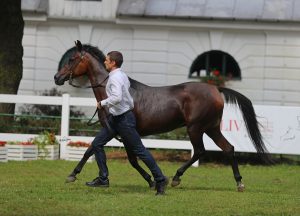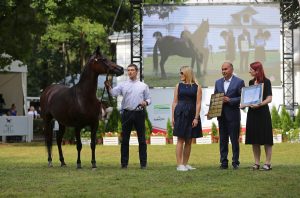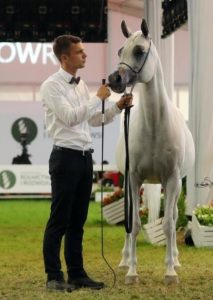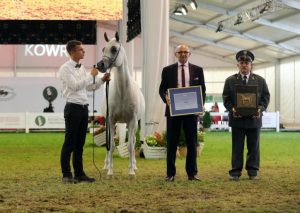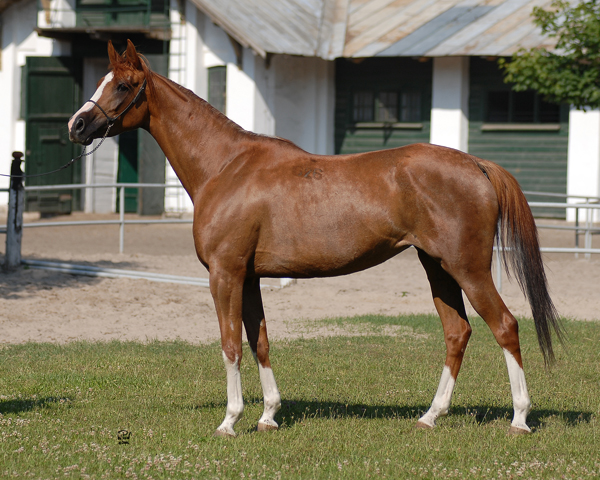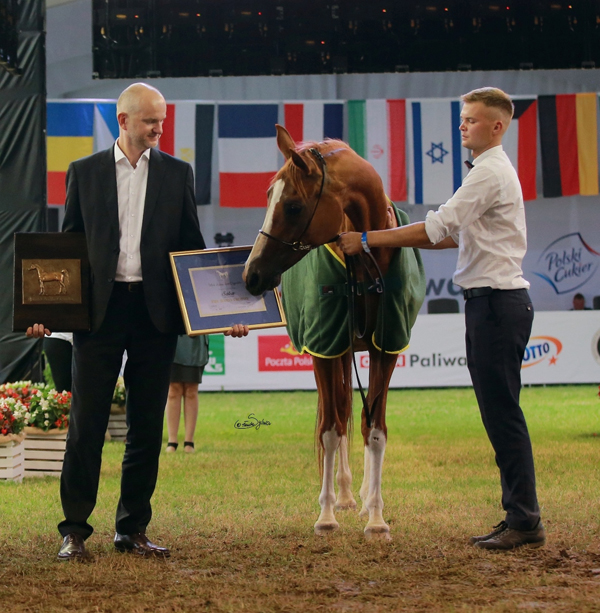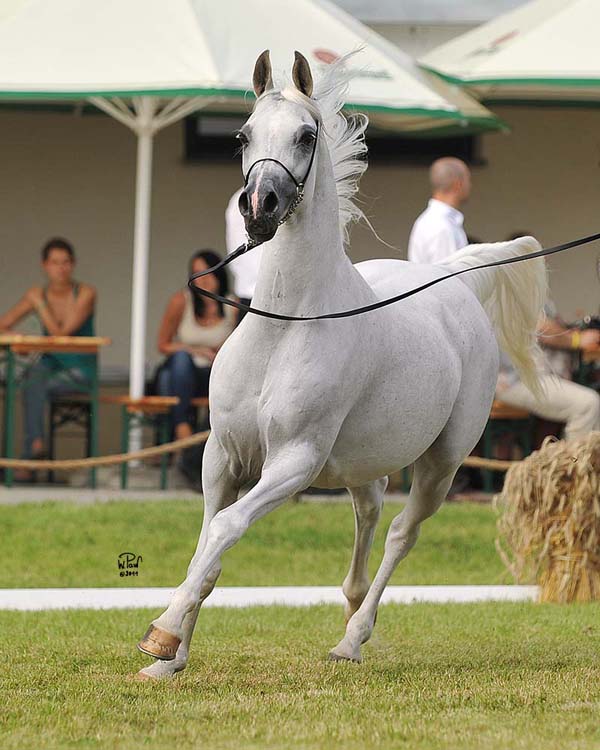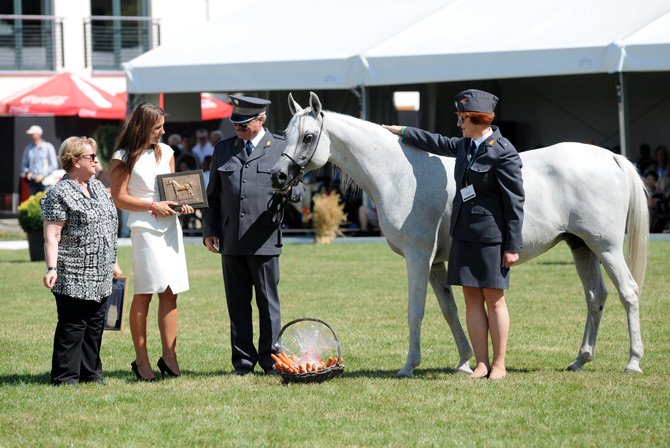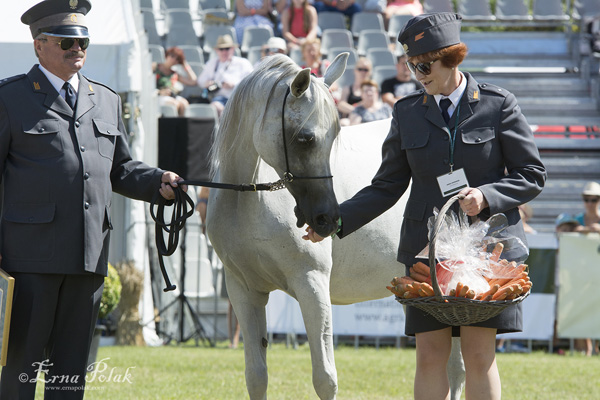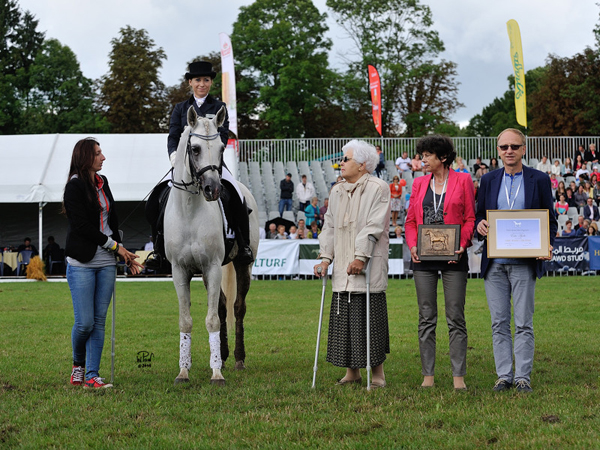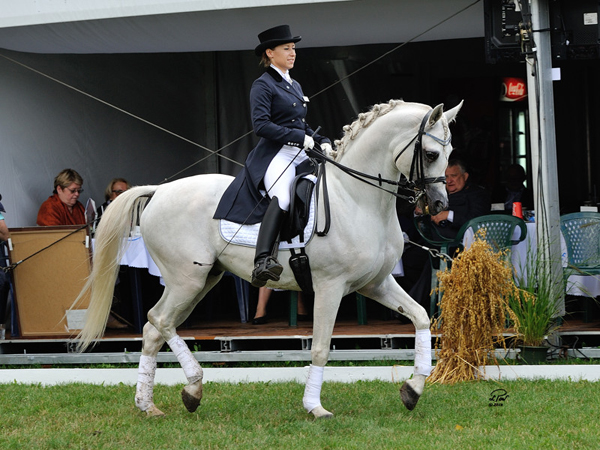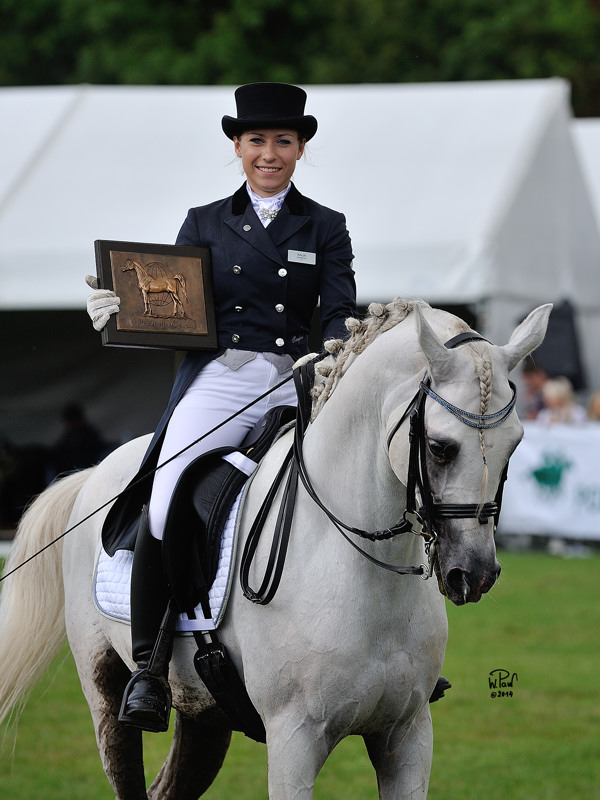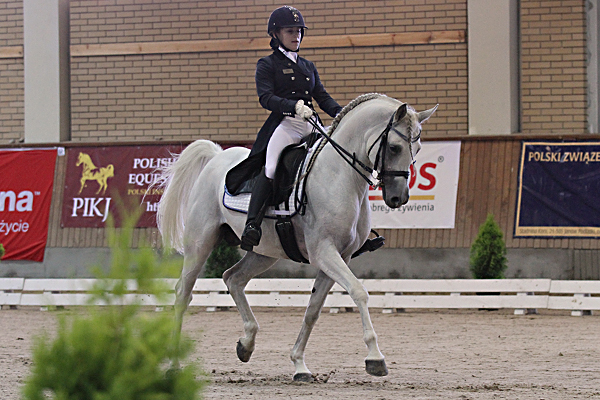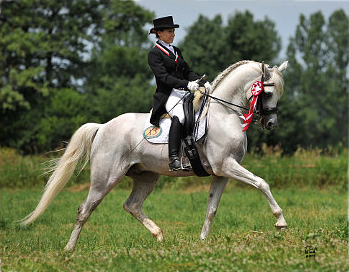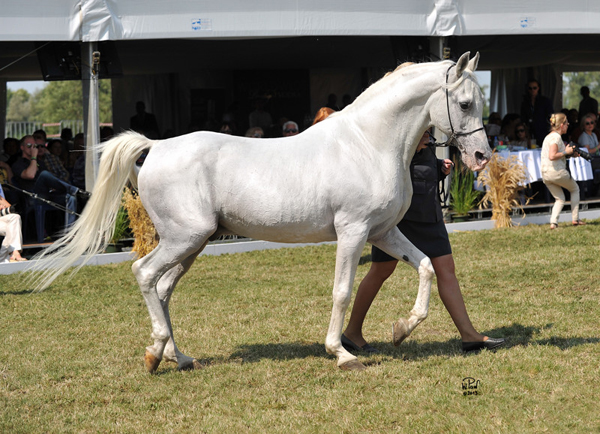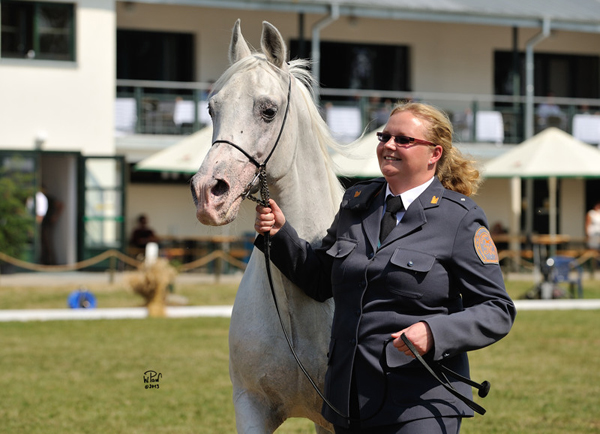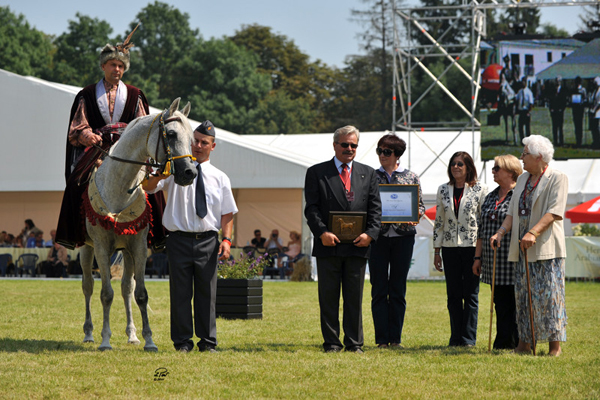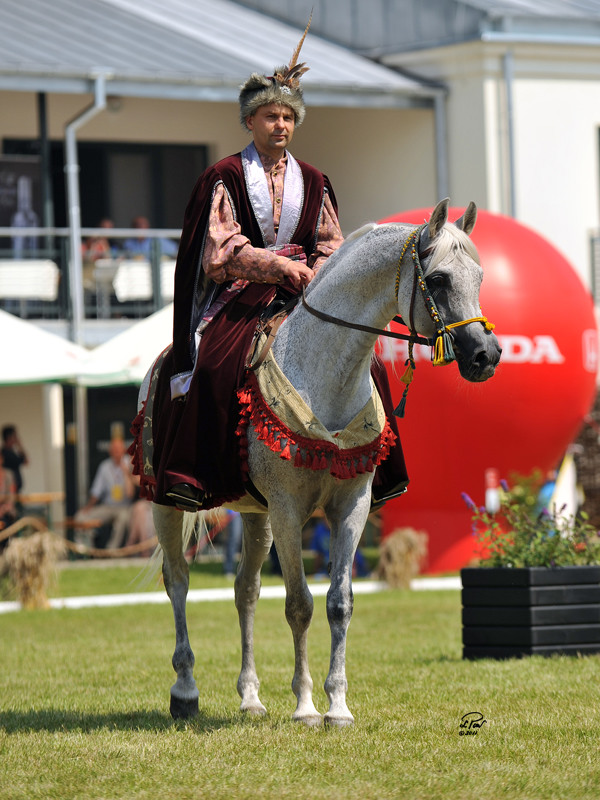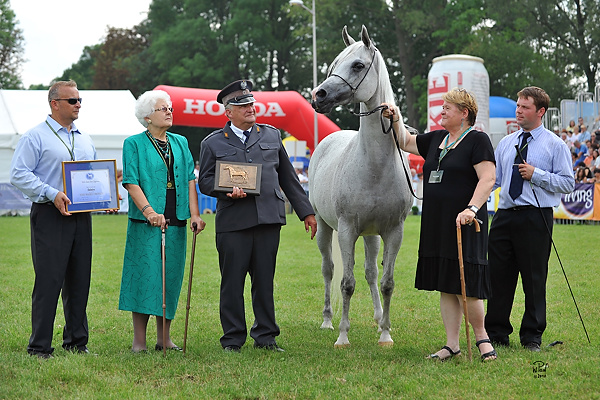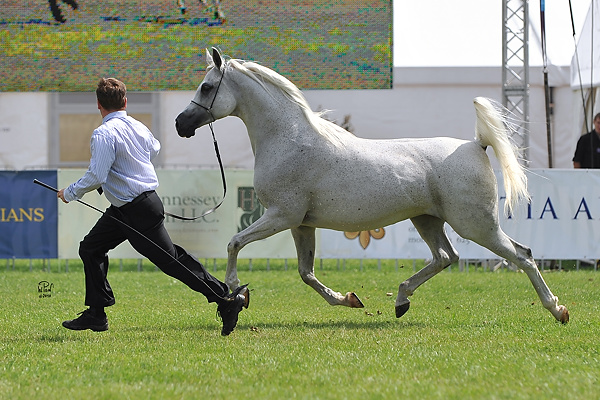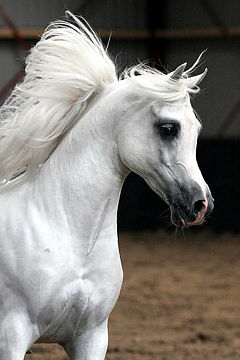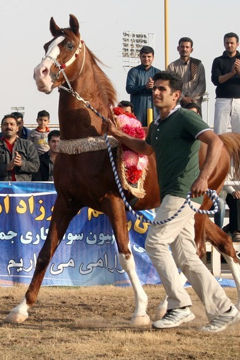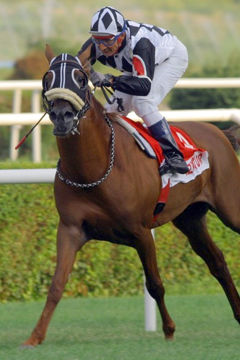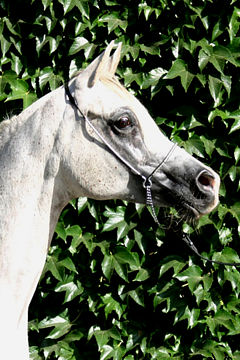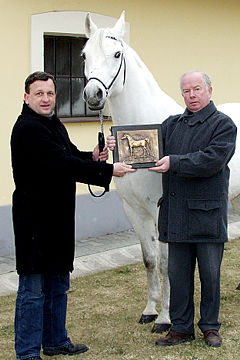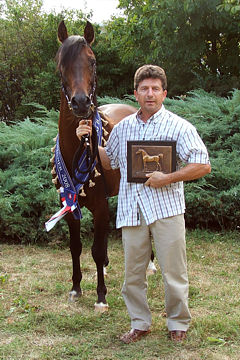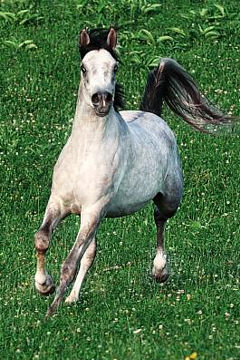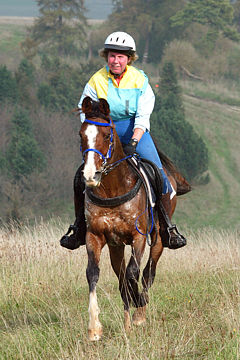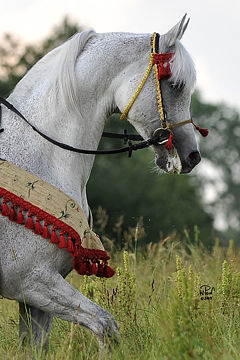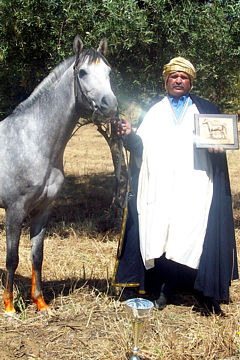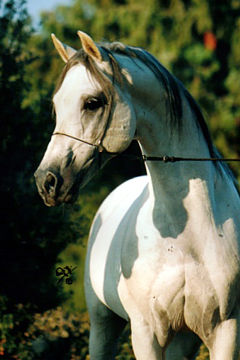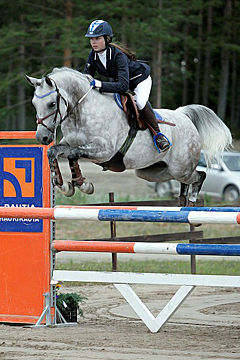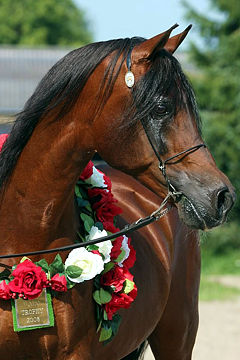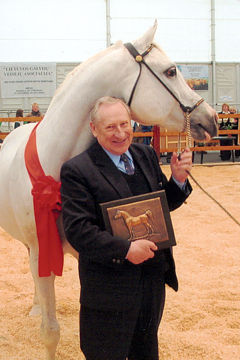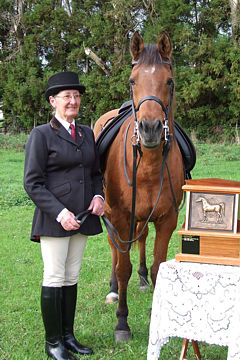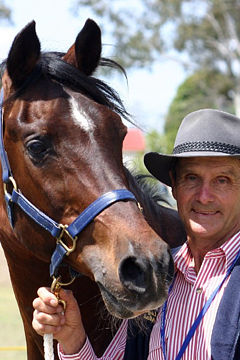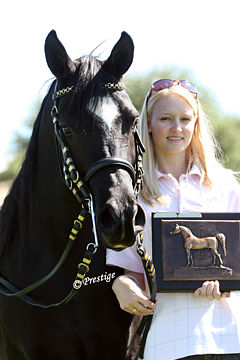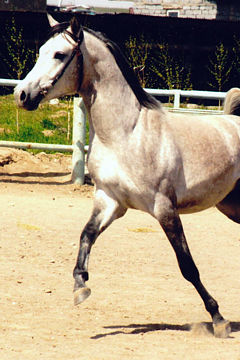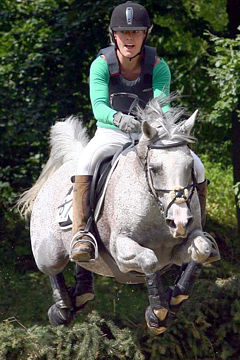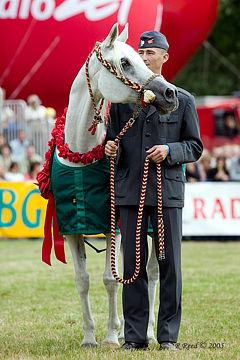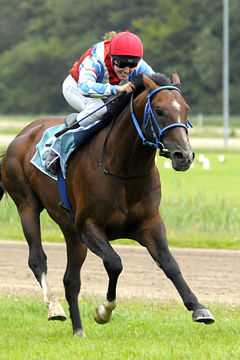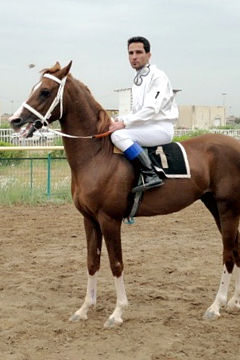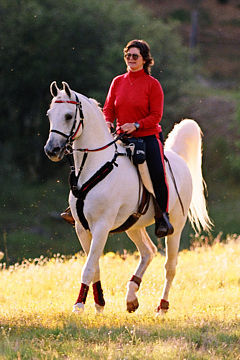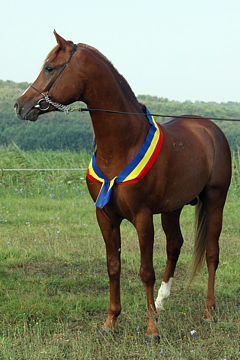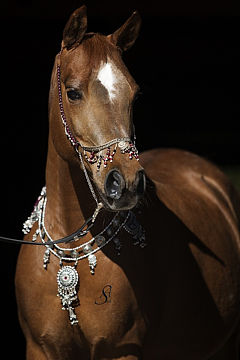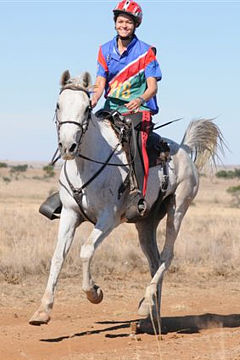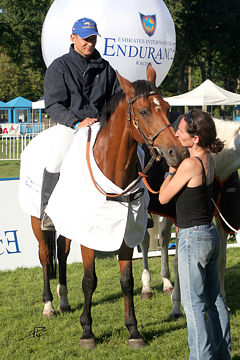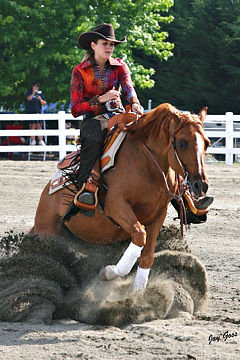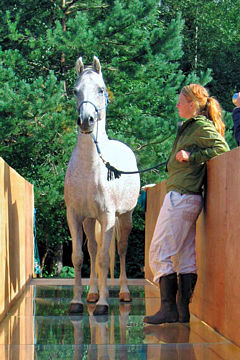![]()
Member Report from Poland
REPORT MADE AT THE 2022 CONFERENCE
Mr. President, Executive Committee Members, delegates, ladies and gentlemen. My name is Joanna Krawczyk, I have the honour to present Poland’s delegate report as the Keeper of the Polish Arabian Stud Book. Accompanying me is Mr. Krzysztof Kierzek, the President of the Polish Jockey Club, where the Polish Arabian Stud Book is maintained. But first I would like to thank HRH Princess Alia Al Hussein, as well as the Organizing Committee from the Royal Stables for hosting this wonderful WAHO Conference.
50 years ago, in 1972, Poland became one of the original founder Member countries of the World Arabian Horse Organization. The Polish Arabian Stud Book (PASB) has been maintained since 1926, although our pedigree records go much further back than that (mentions of the first records date back as far as 1803 from the stud in Szamrajówka). In 2021 the PASB celebrated its 95th anniversary. The PASB is managed by the Polish Jockey Club under the authority of the Ministry of Agriculture. Our Registry office is located at the historic Służewiec Racetrack in Warsaw. Over the last four years our statistics in terms of the number of broodmares and stallions entered for breeding has remained fairly steady.
| 2018 | 2019 | 2020 | 2021 | |
| foals | 647 | 651 | 609 | 584 |
| broodmares | 1134 | 1110 | 1080 | 1160 |
| stallions used in breeding | 184 | 161 | 176 | 188 |
| exports | 197 | 185 | 239 | 231 |
| imports | 43 | 36 | 17 | 41 |
The number of foals born each year has been slowly declining, however this can be linked to the number of exports, which are increasing. as most of the exports are pregnant mares and therefore the foals that they carry are born abroad. Especially since the number of broodmares remains more or less the same.
From a total of 1160 mares entered for breeding, 299 of them are at the three national State Studs. At Janów Podlaski State Stud, which was established in 1817, there are 117 broodmares. At Michałów State Stud, established in 1953, there are 132 broodmares and at Białka Stud, established in 1981, there are 50 broodmares. We are pleased to report that the number of private breeders has been increasing year on year for some time, and today between them they own 861 broodmares, although of course not all are bred from each year. There are 6 private breeders/studs that have 20 broodmares or more and between them they have 369 broodmares in total.
When it comes to foals, out of the 584 born in 2021, 155 were born at the national State Studs and 429 were born at private breeders.
The PASB complies with all EU directives and WAHO registration rules. All our foals have been parent verified by DNA since 2004, and we introduced microchipping in 2010. Artificial insemination is allowed, and there is no longer any time limit on the use of frozen semen from deceased stallions. Embryo transfer has been allowed since 2011, but with a set limit of one naturally born foal and one embryo transfer foal per mare per year.
Genetic disorder testing is not mandatory. In a study carried out in 2017 by the National Institute of Animal Production 448 horses registered in the PASB were tested for SCID (Severe Combined Immunodeficiency), CA (Cerebellar Abiotrophy) and LFS (Lavender Foal Syndrome). The results showed no SCID and LFS carriers and a CA mutation at a level of 11.4%, but only in heterozygotic forms. Testing is possible in various laboratories for those that would like to check their horse.
Polish Arabians have always been regarded as versatile, we like to think of them as both “brave and beautiful”, but more recently some of our breeders have been focusing and specializing in breeding for particular disciplines. The most popular activities that Arabians are bred for are shows and racing.
Racing has always been an important part of the Polish Arabian breeding program, used as a testing ground for the athletic abilities of the horses. It is worth noting that many of our top show horses have spent at least one year, if not more, in race training, many of them with excellent results. In 2021 our Arabian racing program comprised 191 individual races, in which 305 horses took part with a total of 1,474 starts between them. We have several Stakes and Classic races, as well as the Group 3 Sheikh Zayed Bin Sultan Al Nahyan Europa Cup, an International race for 4 year olds and older over 2600 metres, which is part of the international Pattern system, the highest level of races. Our Arabians debut at the track at the age of 3. In 2021 there were 168 three-year olds at the track, out of 647 born in 2018, meaning that 26% of that year’s crop participated in racing.
Showing is also very popular in Poland. There used to be a total of 6 halter shows each year, including an A-category show – the Al Khalediah European Arabian Horse Festival. However the pandemic took its toll on private show organizers and in 2021 only three shows were held. The two shows with the longest tradition – and which have been held without interruption – are the Junior Spring Show at Białka Stud, which has been held since 1983, and our Polish National Championships held annually in Janów Podlaski since 1979. This year the Polish Nationals held the Geldings Championship for the first time, which is a nod toward private owners. This class is sure to attract more and more private owners and their geldings in the future. Overall it is difficult to estimate the percentage of Arabians which participate in shows, but we have taken as an example the Junior Spring Show. This show is for horses aged 1 to 3 years old only and is considered as the first opportunity to assess the quality of the juniors and their “entryway” into the show world. This year 49 junior colts and fillies were entered for this show, out of the 584 registered in 2021, which means 8.4% of that year’s foal crop took part.
As regards to other activities, endurance is increasing in popularity and as our riders gain more experience, our international team is improving its results all the time. In 2021 there were around 15 endurance events open to all breeds, at various distances, with the Arabians dominating the results as usual.
Throughout the year many Arabian horses, including many of the breeding stallions from the State Studs, compete in a variety of sports including dressage, show jumping and western riding. Some of these are also in open competition against other breeds. Ridden classes are also popular, in particular Classic Pleasure, Costume classes, and even Ladies Side-saddle classes. Most of these disciplines are represented at the Polish National Championships for Arabian Sport Horses, which in 2016 was held at Michałów Stud. In 2015 Janów Podlaski Stud hosted the European Arabian Horse Sport Championships and our riders compete abroad successfully whenever this Championship is held elsewhere. Of course, as in all countries, the Arabian remains popular as a family horse, for pleasure riding both for adults and children.
Arabians are definitely the most popular breed in our country, they are well known to all Polish people because their long history is so interwoven with the history of Poland that we consider them as our national treasure. The main event of year in Poland, but also of worldwide importance, are the Arabian Horse Days, which include the Polish National Show (held since 1979) and the world-famous auction (the Pride of Poland Sale) since 1970 held at Janów Podlaski Stud; this draws the attention of the worldwide Arabian community, as well as the mainstream media, which brings excellent publicity to the breed. Each year at this event an outstanding individual horse is honoured with the WAHO Trophy. Arabians are mostly associated with being beautiful show horses. When awarding the WAHO Trophy, the Polish Arabian Stud Book uses this opportunity to showcase all facets of the Arabian horse. In 2021 the WAHO Trophy was awarded to the privately bred Almina, a dam of several excellent racing horses, including Derby and Oaks winners.
There are currently two organizations for Arabian horse enthusiasts: the Polish Arabian Horse Breeders Association (PZHKA), established in 1997, which is an Associate Member of WAHO, and the newly formed Polish Arabian Horse Owners Association. Seminars, lectures, and judges’ training courses are all arranged to help educate and inspire our owners and breeders.
Before I conclude the report from Poland, I must pass on the sad news of the passing of Krystyna Karaszewska, a long time keeper of the Polish Arabian Stud Book. Krystyna passed away on the 28th of September, 2022, just two days away from her official retirement. She is a figure inextricably linked with the Racing Track at Służewiec. She started working at the races in 1968, and from 1970 she became the Keeper of the Stud Book. Although she is mainly associated with the Stud Book, it should be mentioned that Krystyna was also the head of the racing department, an advisor to the Polish Jockey Club President, a racing steward and a highly valued racing commentator. She will be greatly missed by all that knew her.
2019 REPORT:
The Polish Arabian Stud Book has provided the following information. In 2017, 603 foals were registered. 152 horses were exported and 23 horses imported. There were 5 halter shows, 199 races and 16 endurance competitions. In 2018 around 600 foals were registered, 129 horses were exported and 24 horses were imported. There were 5 halter shows, 196 races and 6 endurance events. Other popular activities include pleasure riding and driving.
REPORT AT 2017 WAHO CONFERENCE:
Joanna Krawczyk, Poland: Mr. President, Vice-President, Executive Committee Members, Delegates, Ladies and Gentlemen. My name is Joanna Krawczyk, I have the honour to present Poland’s delegate report in the name of Krystyna Karaszewska, Registrar of the Polish Arabian Stud Book. But first I would like to thank His Majesty King Hamad and His Highness Sheikh Isa Bin Salman Al Khalifa, as well as the Organizing Committee from the Royal Studs for hosting this wonderful WAHO Conference.
Poland was one of the original founder member countries of the World Arabian Horse Organization. The Polish Arabian Stud Book (PASB) has been maintained since 1926, and in 2016 we celebrated the 90th anniversary. The Polish Arabian Stud Book is managed by the Polish Jockey Club under the authority of the Ministry of Agriculture. Our Registry office is located at the historic Służewiec Racetrack in Warsaw. Since the last WAHO Conference in 2014, our statistics in terms of the number of broodmares and stallions entered for breeding have remained fairly steady, which you can see on the screen. We have noted a good increase in foal registrations, rising from 505 in 2015, to 558 in 2016. We always have many more exports than imports, with 337 exports and 19 imports in the year 2015, and 170 exports and 31 imports in 2016.
From a total of 1,050 mares entered for breeding last year, 242 of them are at the three State Studs, at Janów Podlaski 95 broodmares, at Michałów 105, and at Białka Stud 42. We are pleased to report that the number of private breeders has been increasing year on year for some time, and today between them they own 808 broodmares, although of course not all are bred from each year. The largest of the private stud farms have about 15 broodmares. In all there are 4,000 living Arabian horses in Poland.
We comply with all EU directives and WAHO registration rules. All our foals have been parent verified by DNA since 2004, and we introduced microchipping in 2010. Artificial insemination is allowed, and there is no longer any time limit on the use of frozen semen from deceased stallions. Embryo transfer has been allowed since 2011, but with a set limit of one naturally born foal and one embryo transfer foal per mare per year.
Polish Arabians have always been regarded as versatile, we like to think of them as both brave and beautiful, but more recently some of our breeders have been focusing and specializing in breeding for particular disciplines. Racing has always been an important part of the Polish Arabian breeding programme, used as a testing ground for the athletic abilities of the horses. It is worth noting that many of our top show horses have spent at least one year, if not more, in race training, many of them with excellent results. In 2016 our Arabian racing programme comprised 223 individual races, in which 311 horses took part with a total of 1,751 starts between them. We have several Stakes and Classic races, as well as the Group 3 Sheikh Zayed Bin Sultan Al Nahyan Trophy (Europa Cup), an International race for 4 year olds and older over 2600 metres, which is part of the international Pattern system, the highest level of races. Our Arabians debut at the track at the age of 3. In 2016 there were 176 three-year olds at the track, out of 563 born in 2013, meaning that 31.26% of that year’s crop participated in racing.
Showing is also very popular in Poland, with a total of 6 halter shows each year. The two with the longest tradition are the Junior Spring Show held in Białka since 1983, and our Polish National Championships held annually at Janów Podlaski since 1979. Over the past 5 years more shows have been added to cater to the increasing interest of our owners, these are the Warsaw Championships, the Al Khalediah European Arabian Horse Show, the All Polish Championships and the Cracow Arabian Horse Show. The last two, both initiated in 2016, introduced foal classes for the first time in Poland. Overall it is difficult to estimate the percentage of Arabians which participate in all these shows, but we have taken as an example the Junior Spring Show. This is for horses aged 1 to 3 years old only and is considered as the first opportunity to assess the quality of the yearlings, so entries are normally good for these classes. Last year 61 yearling colts and fillies were entered for this show, out of the 505 registered in 2015, which means 12.1% of that year’s foal crop took part.
As regards to other activities, endurance is increasing in popularity and as our riders gain more experience, our international team is improving its results all the time. In 2016 there were more than 20 endurance events open to all breeds, at various distances, with the Arabians dominating the results as usual. Throughout the year many Arabian horses, including many of the breeding stallions from the State Studs, compete in a variety of sports including dressage, show jumping and western riding. Some of these are also in open competition against other breeds. Ridden classes are also popular, in particular Classic Pleasure, Costume classes, and even Ladies Side-saddle classes. Most of these disciplines are represented at the Polish National Championships for Arabian Sport Horses, which in 2016 was held at Michałów Stud. In 2015 Janów Podlaski Stud hosted the European Arabian Horse Sport Championships and our riders compete abroad successfully whenever this Championship is held elsewhere. Of course, as in all countries, the Arabian remains popular as a family horse, for pleasure riding both for adults and children.
Arabians are definitely the most popular breed in our country, they are well known to all Polish people because their long history is so interwoven with the history of Poland that we consider them as our national treasure. The main events of year in Poland, but also of worldwide importance, are the Arabian Horse Days, which include the Polish National Show and the world-famous auction, the Pride of Poland Sale held since 1970 held at Janów Podlaski. This event draws the attention of the worldwide Arabian community, as well as the mainstream media, which brings excellent publicity to the breed. Each year at this event an outstanding individual horse is honoured with the WAHO Trophy, which in 2016 was awarded to Michałów’s internationally famous show and broodmare, Emandoria.
There are currently two organizations for Arabian horse enthusiasts: the Polish Arabian Horse Breeders Association, established in 1997, which is an Associate Member of WAHO, and the newly formed Polish Arabian Horse Owners Association. Seminars, lectures, and judges’ training courses are all arranged to help educate and inspire our owners and breeders. That concludes the report from Poland. Thank you for your attention.
REPORT AT 2014 WAHO CONFERENCE:
Dr. Marek Trela, Poland: (This report was accompanied by a visual presentation of slides showing various statistics, horses and people). Mr. President, Executive Committee Members, members of the organizing committee, delegates, ladies and gentlemen. My name is Marek Trela, I have the honour to present Poland’s delegate report in the name of Mrs. Krystyna Karaszewska, Registrar of the Polish Arabian Stud Book, for the 2014 WAHO General Meeting. But first of all I would like to express our great thanks to the Qatar Racing and Equestrian Club for their great hospitality and perfect organization of our meeting.
The horse, and especially an Arabian one, has a significant place in Polish history and culture. It has been similarly important in the development of the noble horse breeds, which once were so indispensable during the time of war as well as in the time of peace. Due to its geographical position then, with borders reaching the Black Sea and the neighbouring Ottoman Empire, during the 15th to 18th centuries Poland always had an easy and constant access to horses of the oriental breed coming from Arabia. The noble and high quality specimens of oriental origin were finding their way to aristocratic stables, landlords’ manors and royal castles. Breeders in Poland recognized the worth of an Arabian horse, not only appreciating its usefulness but also the horse’s courage, intelligence, grace and beauty. The horses of Arabian blood were bred with great fondness and care. The studs of Polish magnates were known all over Europe and highly valued for their quality. A long history of the Arabian horse breeding in Poland, as the history of our country with its turns of glory and drama, could be easily the topic of an exciting movie. This image shows 3 famous foundation mares of the Arabian breed in Poland, imported in 1845, they are Gazella, Mlecha and Sahara.
This is an interesting example of our earliest records, it is the Slawuta Stud Register for the year 1860 showing the fillies born that year, sired by desert bred imported stallions such as Seglawi-Ardzebi and Kohejlan Abu-Argub, and Slawuta-bred stallions such as Iskander-Basza. The Polish Arabian Stud Book, PASB, was founded in 1931. The first volume of the stud book was published in 1932. According to the Act of the Ministry of Agriculture, PASB is maintained at present by the Polish Jockey Club with the headquarters office located in Warsaw at the Służewiec Racecourse.
Since the last 2011 WAHO General meeting in Doha, Qatar, PASB has the following registration figures to report. 620 foals were registered in 2011, dropping slightly to 602 in 2012 and decreasing again in 2013 to 563. The number of broodmares is also gradually decreasing, from 1,086 in 2011 to 1,056 in 2012, and to 1,009 in 2013. The number of stallions active in breeding on the other hand, is increasing slightly each year, from 238 in 2011 to 256 in 2017 and 277 in 2013. We recorded 59 exports in 2011, this jumped considerably to 204 in 2012 and amounted to 100 in 2013. As for imports, these were 12 in 2011, and 20 in each of the years 2012 and 2013. There are many private breeders in Poland, most with a small number of broodmares, unfortunately the figures show they have been decreasing slightly, from 273 in 2011, to 261 in 2012 and 247 in 2013.
The current stud book Volume 16 supplement 5 is produced by the PASB database and covers the year 2012. The Polish Arabian Stud Book is switching its system from publishing printed stud books to the electronic ones. The electronic data is available on request. DNA testing has been used and has been mandatory since the year 2004. The parent verification of all foals is mandatory before registration but not later than up to 31st December in the year they are born. Microchipping is mandatory since 2010. Passports have been in use and mandatory since 2004, a sample has been brought to the Conference by the Registrar of PASB. Artificial insemination and transported semen both imported and exported, are allowed to be used. The frozen semen of a stallion which died is allowed to be used for one year from his death only. Embryo Transfer once a year per mare is allowed since the year 2011.
The total estimated number of living pure-bred Arabian horses counts at present in Poland about 4,000. The structure of pure-bred Arabian breeding is as follows: 3 State Studs with the total number of 273 broodmares; 247 private breeders with the total number of 736 broodmares. The National Studs are Janów Podlaski established in 1817, Michalów established in 1953, and Bialka established in 1981. One of the oldest and most important Polish private studs is Chrcynno Palace Stud.
The most popular activities for Arabians in Poland are:
Racing – there were 238 flat races for 328 Arabian horses in the 2013 racing season, at 3 racecourses: the principal course in Warsaw, then in Wrocław and in the summer season in Sopot.
Showing, both in halter and ridden: 5 ECAHO affiliated shows took place in Poland in 2014, including the Polish National Arabian Horse Show; the European Arabian Horse Sport Championships with classic, costume, dressage, jumping and western classes; the Polish National Arabian Horse Sport Championships in Janów Podlaski State Stud and the International Al Khalediah Poland Festival. There is also the Spring Show at Bialka Stud, which is probably the biggest show in Europe for 1 to 3 year old horses only. The sport events for Arabian horses are becoming more and more popular, we hosted the European Arabian Horse Sport Championships last year and probably will do so again next year.
Endurance riding is also popular, there were 16 meetings in 2013 which were organized by the Polish Equestrian Federation Endurance Division, open for all breeds. The purebred Arabian horses are definitely dominating in this discipline.
The 2014 WAHO Trophy winner is Echo Apollo, grey stallion born 2006 by Piaff out of Echo Kallisto by Pamir, bred by Chrcynno Palace Stud. This breeding stallion won Sports championships several times and is a gold medallist. This is how we are trying to support the use of Arabian horses.
In terms of Promotion and Education, a very important event is of course the Polish Arabian Days Show and Sale organized in August at Janów Podlaski State Stud. There is always official TV coverage of this event, which includes the ceremony of awarding the WAHO Trophy. There is also the extremely informative activity of the websites of State Studs, particularly of Janów Podlaski State Stud with its pedigree database, news, articles, show and race results, live transmissions from the most important European shows, links to WAHO, ECAHO, the Polish Arabian Stud Book and other organizations active on the Arabian horse field. The website address is www.janow.arabians.pl.
We also have the publication of the quarterly Araby Magazine with numerous articles on history, breeding, racing, endurance and equestrian sports within the Arabian breed, we distributed copies of this magazine this morning. We also have the strong educational activity of the Polish Arabian Horse Breeders Society, PZHKA, which is an Associate Member of WAHO, organizing seminars, courses, shows, presentations and other events, with its very well mastered website hosted by Janów Podlaski website. There are also several very interesting home pages and websites connected to the Polish private studs and promotional organizations.
The PASB Registry office helps breeders to facilitate registration procedures by giving complete information on the website on the websites of the PZHKA and on the website of the Polish Jockey Club, and on the occasion of seminars and meetings, this is as well as keeping registration and paperwork fees on a safe level. Thank you very much for your attention.
REPORT AT 2011 WAHO CONFERENCE:
Dr. Marek Trela, Poland: (The report was read out in conjunction with the visual Power
Point presentation with the same text, illustrated as relevant). Mr. President, dear delegates, ladies and gentlemen. In the name of the Polish Jockey Club, Polski Klub Wyscigów Konnych, represented here by Mrs. Krystyna Karaszewska, who is our Registrar, I would like to present Poland’s Delegate Report for the 2011 WAHO General Assembly here in Doha.
The Polish Arabian Studbook, according to the Act of the Ministry of Agriculture, is maintained by the Polish Jockey Club with the seat located in Warsaw. Since the WAHO General Assembly in Muscat, Oman, in 2009 the Polish Arabian studbook registered 650 foals, 1080 broodmares and 230 stallions active in breeding, 92 exported horses and 8 imported horses. In 2010 there were 598 foals, 1068 broodmares, 220 stallions active in breeding, 155 exported horses and 8 imported. One has to admit the stabilization of Arabian horse breeding in Poland with regard to the number of horses and breeders. At present all efforts are directed towards the breeding stock.
There are the following reasons of the significant progress of the Polish breeding: the growing economy and generally stable interior and exterior political situation; the rapid growth of standard of living of the Polish citizens and search for luxurious good and other sides of life than consumption; the great promotional aspect of the Arabian Horse Days Show and Sale, which is organized in August at Janów Podlaski State Stud, with the official television coverage including the ceremony of awarding the WAHO Trophy. There is also the extremely informative activity of the websites of the three State Studs, particularly of Janów Podlaski State Stud with its pedigree database, actualities, articles, show and race results, live transmissions from the most important European shows, links to WAHO, ECAHO, Polish Arabian Stud Book and other organizations active in the Arabian horse field. We also have the publication of the quarterly magazine ‘Araby’ with numerous articles on history, breeding, racing, endurance and equestrian sports within the Arabian breed. Also important is the strong educational activity of the Polish Arabian Horse Breeders Society, which is an Associate Member of WAHO, in organizing seminars, courses, shows, presentations and other events, with its very well mastered website hosted by Janów Podlaski’s website. There are also several interesting homepages of the Arabian horse-connected Polish private studs and promotional organizations. We strongly believe that thanks to the efforts mentioned above, the Arabian horse is the most popular of all the horse breeds in Poland, is highly respected and loved, not only by the horse breeders but also by ordinary people, politicians, media etcetera. The magic name “Purebred Arabian Horse” opens even very tightly closed doors and is called “the national treasure”.
The total estimated number of living purebred Arabian horses should be, at present, around 4,000. The structure of the purebred Arabian breed in Poland is as follows: there are three State Studs with the total number of 264 broodmares, at Janów Podlaski established in 1817, at Michalów established in 1953 and at Bialka, established in 1981. The private breeders have a total number of 334 broodmares. The current studbook, volume 16 supplement 4, is performed by the PASB database and covers the year 2010. The Polish Arabian Stud Book is switching its system from publishing printed stud books to electronic ones. The past and present volumes and supplements in electronic version should be ready by the end of 2012, however the electronic data is available on request.
The DNA testing has been used and mandatory since the year 2004, the parent verification of all foals before the registration is mandatory. The microchipping is mandatory since 2010. Passports have been in use and mandatory since 2004. The use of artificial insemination, transported semen both imported and exported, is allowed. The frozen semen of a stallion which has died is allowed to be used for one year from his death only. The use of embryo transfer is allowed since the year 2011.
The most popular activities for Arabians in Poland are as follows. Racing: There were 202 flat races for 241 Arabian horses in the 2010 racing season, at three racecourses; the principal racecourse in Warsaw, then in Wroclaw and in the summer season in Sopot. Showing: Both in halter and ridden. In 2010 three ECAHO ‘C’ Shows were held and also the Polish National Arabian Horse Show and the Polish All-Arabian Sport Championships with classic and costume classes, dressage and jumping, were held at Janów Podlaski State Stud. The sport events for the Arabian horses are becoming more and more popular. Endurance Rides: 12 meetings were organized in 2010 by the Polish Equestrian Federation’s Endurance Division, open for all breeds. The purebred Arabian horses are definitely dominating in that discipline.
The 2011 WAHO Trophy winner is Piaff, grey stallion born in 1997 by Eldon out of Pipi by Banat, bred by Janów Podlaski State Stud. The Polish Arabian Stud Book Registry Office helps the breeders to facilitate the registration procedures by giving the complete information on the internet, on the Polish Jockey Club website, and on the occasion of seminars and meetings as well as keeping the registration and paperwork fees on a safe level.
We would like to express our grateful thanks to the State of Qatar for their great hospitality which we feel during this meeting. Thank you very much.
REPORT MADE AT 2009 WAHO CONFERENCE
Mrs. Krystyna Karaszewska who is the Registrar, and myself, Dr. Marek Trela, represent the Polish Arabian Stud Book, one of the original foundation registry members of WAHO.
The total estimated number of living purebred Arabian horses is at present around 4,000. Our current published stud book is Volume 15 supplement 1, up to the year 2002. We are currently switching our system from publishing stud books to electronic ones. The next volumes and supplements in electronic version will be ready by the end of 2009, however the electronic data is already available on request.
DNA testing has been mandatory since the year 2004, the parent verification of all foals before registration is also mandatory. Poland is not yet using microchipping but this will be introduced as mandatory by the end of 2009. Passports are in use and also mandatory since 2004. The use of Artificial Insemination and transported semen both imported and exported are allowed. The frozen semen of a stallion which has died can only be used for one year from the date of his death. We are not yet using Embryo Transfer.
The most popular activities for Arabians in Poland are:
Racing: There were 202 races for 241 Arabian horses in 2008 racing season at three racecourses, the principal course in Warsaw, then in Wroclaw and in the summer season in Sopot.
Showing, both in halter and ridden: We held 3 ECAHO C shows in 2008 including the Polish National Championships and the All-Arabian Sport Championships which has classic and costume classes, dressage, show-jumping, and western riding. We are pleased to report that these ridden events for Arabian horses are becoming more and more popular.
Endurance Rides: 15 meetings were organised in 2006 by the Polish Equestrian Federation’s Endurance Division, open for all breeds. The purebred Arabian horses are definitely dominating in that discipline. Altogether there are approximately 80 purebred Arabian horses registered for the sport events with the Polish Equestrian Federation.
The structure of the purebred Arabian breed in Poland is the following: three State Studs with a total number of 250 broodmares between them, which are: Janów Podlaski – established in 1817; Michalów – established in 1953; and the youngest Bialka – established in 1981. And there are now about 200 private breeders with the total number of 830 broodmares between them. During the last three years a further significant development of purebred Arabian breeding has been noticed in our country, particularly as far as private breeders are concerned. During this short time the number of registered foals per year has increased by nearly 7%; the number of mares entered for breeding has increased by nearly 15%; the number of stallions active in breeding has increased by 24%; the number of exports has risen by 24%, and the number of imports has risen from just 4 horses in 2005 up to 26 in the year 2008.
The reasons for this increased interest in Arabian horses are varied and include the following: Poland’s growing economy and generally stable political situation; the rapid growth in the standard of living of Polish citizens who are now able to revive their long tradition of horse-ownership and equestrian sports as a popular leisure activity; the great promotional aspects of our Polish Arabian Days, which is the Annual Show and Sale organised at Janów Podlaski State Stud with official television coverage including the WAHO Trophy award ceremony; the extremely informative activity of the websites of our State Studs particularly of Janów Podlaski State Stud with a pedigree database, news, articles, show and race results, live transmissions from the most important European shows, links to WAHO, ECAHO, Polish Arabian Stud Book and other organizations active in the Arabian horse field; the publication of the quarterly magazine ‘Araby’ with numerous articles on history, breeding, racing, endurance and equestrian sports within the Arabian breed; the strong educational activity of the Polish Arabian Horse Breeders Society which organizes seminars, educational and judges training courses, shows, presentations and other events as well as running its own very popular website. The tasks of the Polish Arabian Horse Breeders Society, which is an Associate Member of WAHO, is to promote the Arabian breed on country level and worldwide, and to educate the new owners and public on the history, care and uses of the purebred Arabian horse. There are also many other interesting websites connected to the increasing number of Polish private studs and promotional organizations.
Our 2008 WAHO Trophy winner was the stallion Ekstern, by Monogramm out of Ernestyna, bred by Michalów State Stud. He is the well known sire of international champions and is himself the undefeated Triple Crowned winner of the Nations Cup, European and World Championship titles.
We strongly believe that thanks to the above mentioned efforts the Arabian horse is the most popular of all horse breeds in Poland, is highly respected and loved not only by the horse breeders but also by the ordinary people, politicians, media and so on. The magic name “purebred Arabian horse” opens even very tightly closed doors and is our “national treasure”. That concludes the report for Poland. Thank you.
REPORT MADE AT 2007 WAHO CONFERENCE:
The Polish Arabian Stud Book according to the Act of the Ministry of Agriculture is maintained by the Polish Jockey Club with its office located in Warsaw. In 2005 the Polish Arabian Stud Book registered 592 foals, with 945 broodmares and 162 stallions active in breeding, 82 horses exported and only 4 horses imported. In the year 2006, we registered 571 foals, with 970 broodmares, 164 stallions active in breeding, 60 horses exported and 9 horses imported.
During the last 5 years a significant development of purebred Arabian horse breeding has been noticed in our country. In 2002, PASB registered 424 foals, which was 147 less than in 2006. In 2002 there were 723 broodmares which was 252 broodmares less than in 2006. There were 72 stallions active in breeding in 2002, compared to 164 last year. There were 63 horses exported in 2002, and 10 imported. The reasons for this growing interest in breeding Arabian horses are mostly due to our growing economy and generally stable interior and exterior political situation, the rapid growth of standards of living of the Polish people and search for luxury goods. Promotional aspects are also very important, including our Arabian Horse Days National Show and Sale organized every August at Janow Podlaski Stud. Strong educational activities are also run by the Polish Arabian Horse Breeders Society.
The total estimated number of living purebred Arabian horses in Poland is at present about 4,000. The structure of the purebred Arabian breed in Poland is as follows – we have 3 State Studs which are Janow Podlaski, established in 1817; Michalow established in 1953; and the youngest Bialka established in 1981, with a combined total number of 300 broodmares. There are now 175 private breeders with a total number of 675 broodmares. The current published stud book is Volume 15 Supplement 1 covering the year 2002. The Polish Arabian Stud Book is presently switching its system from a printed stud book to electronic ones. These will be ready at the end of the year 2007. DNA testing has been used since 2002, parent verification of foals before registration is mandatory. Poland does not yet use microchipping. We allow the use of Artificial Insemination, transported semen both imported and exported. The frozen semen of stallions which have died can be used for one year from the date of death only. Embryo Transfer is not currently allowed.
The most popular activities for Arabians in Poland are: Racing, there were 265 races in 2006, at 3 racecourses of Warsaw, Wroclaw and Sopot; Showing, both in halter and ridden, we held 4 ECAHO affiliated shows in 2006 including the Polish National Championships and we also held All-Arabian Sport Championships with classic and costume classes at Janow Podlaski Stud. Sport events for purebred Arabian horses are becoming more and more popular, in 2006 and 2007 a spectacular success was achieved by the small 146 cm mare, Niniwa, when she won the title of European Sport Champion in Stadl Paula in the show jumping category. Our shows are run jointly by the Polish Arabian Horse Breeders Society, the Agricultural Property Agency, the State Studs and local administration authorities. Endurance rides are also popular, there were 11 events organized in 2006 by the Polish Equestrian Federation’s Endurance Division, open for all breeds. The purebred Arabian horses are definitely dominating in that discipline.
The Polish Arab Stud Book Registry Office helps breeders to facilitate registration procedures by giving complete information on the internet, on the Polish Jockey Club website, and on the occasion of seminars and meetings, as well as keeping the registration and paperwork fees on a safe level. The tasks of the Polish Arabian Horse Breeders Society, which is an Associate Member of WAHO, are to promote the Arabian breed on a national level and also worldwide, to educate the new owners and the public on the history, care and uses of the purebred Arabian horse; to organize shows, events, seminars, presentations and educational courses; to publish the Arabian horse magazine ‘Araby’ quarterly, and by writing articles for use in various horse magazines.
In 2007, Poland registered 600 foals, and recorded 108 exports together with 15 imports.

